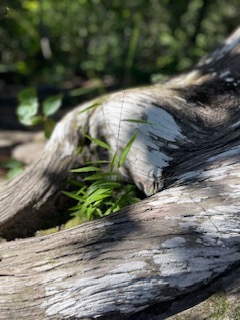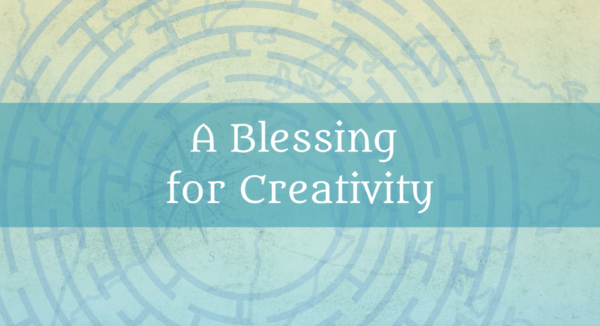I am delighted to share another beautiful submission to the Monk in the World guest post series from the community. Read on for Susan Fish’s reflection on meeting Jesus by a cedar tree.
Imagine walking to a river, my spiritual director says. Sit with Jesus and place your concerns in the water for God to carry. I see myself resting among the exposed roots of a cedar tree, leaning back as the psalmist does in Psalm 131, like a weaned child against its mother. I begin to pray in this way.
The next summer, my husband and I visit Lake Superior. As we hike a trail, I find a cedar grove exactly like the one I imagine in prayer, and so I sit among the roots, against the strong trunk and under the sheltering arms of the real cedar.
Later when my spiritual director says, “Sit in a place where you are at ease,” I imagine that cedar, the light dappled as it was that day.
Jesus comes to you, she says. And he does, but not as I expect. Jesus comes wading through the water, larger than life, long beautiful hair, relaxed but with intense eyes, beautiful.
“Hey,” he says.
My spiritual director says I am to ask him my question, and I do, but the water is rushing around him, and he pulls me to my feet and invites me to step into the water, like what I am saying is beside the point, like I should ask a better question, like we should go wading up-river toward the waterfalls.
I resist—the water is bracingly cold and a bit dangerous and besides I have this question. He reminds me he is perfectly safe in the water, that I can hold his hand and stick with him. I am suddenly reminded of Reepicheep and his heart’s desire in The Voyage of the Dawntreader. I have not thought of this in forever, the mouse in his coracle sailing further up and further into Aslan’s Country.
I get scared that Jesus is inviting me to death, but Jesus asks whether it really matters, that he will be with me and isn’t this the best adventure and most beautiful place?
I agree but I want to go back. I sink back into my body against the tree, only I feel weighed down—this is more like death. Jesus invites me to consider what I actually need to bury. There are two griefs I have carried for years. I bury them and put a marker over the graves.
I take Jesus’s hand. He says that now instead of heading up river, I can ride the rapids downstream, like a child riding a toboggan down a snowy hill. At the bottom, I climb out in the shallows and I know I am to resume my life, that I am not headed for Aslan’s Country, but I look back to Jesus, up river, and he tells me to know he is right here.
*
We return to the same place the following summer. I am eager to repeat the experience, to embark again on an interior spiritual journey in a beautiful wild place.
But as a wise person said thousands of years ago, you can never step into the same river twice. As I enter the trail, I see a sign that tells me its name is a translation of the Ojibwe name of the river. In the year since I last visited this place, I have studied with an Indigenous elder who has given me new eyes to see and enter the space. This sign reminds me this is no terra nullius, that it has a natural and a human history. It isn’t just a pretty setting either. I hope to have a healthier relationship with the place, its people and the Creator who welcomes us all to this place. That means being conscious that it isn’t just there for me but also paying attention to what God says through it. Martin Luther said, “God writes the Gospel not in the Bible alone, but also on trees, and in the flowers and clouds and stars,” while Indigenous naturalist Robin Wall Kimmerer writes, “Traditional teachings recount that the power of cedars is so great and so fluid that it can flow into a worthy person who leans back into the embrace of her trunk.” I hope I am worthy.
Still I expect I know what will happen when I lean back in the embrace of the cedar—but I don’t. In fact, I realize I can’t sit under the tree as I could before, partly because my awareness shows me the tender plants growing in the shelter of the roots, starry moss and tall grasses. I think: these will never grow into trees but they are life too. Then I notice what look like rosebushes. This seems impossible and then I see more roses and I wonder whether it is a garden gone wild, but I also think of my own name which means rose and Mary the mother of Jesus as rose, and I think: there is a place for me here.
At the moment the Church calls the Transfiguration, when the disciples saw Jesus in a new light, their inclination, like ours, was to put up memorials. Something I take away from these experiences is that such moments are gifts uniquely suited for our present needs, not something we can control, prescribe, or repeat. But I also learn we are more likely to experience them when we sit quietly and lean against a tree.

Susan Fish is a writer and editor living in Waterloo, Ontario, Canada with her husband and two puppies. Her third novel, Renaissance (Paraclete, 2023), is a coming-of-age story about a woman of a certain age who also encounters trees, in this case olive trees in Florence, Italy. Visit Susan online.



